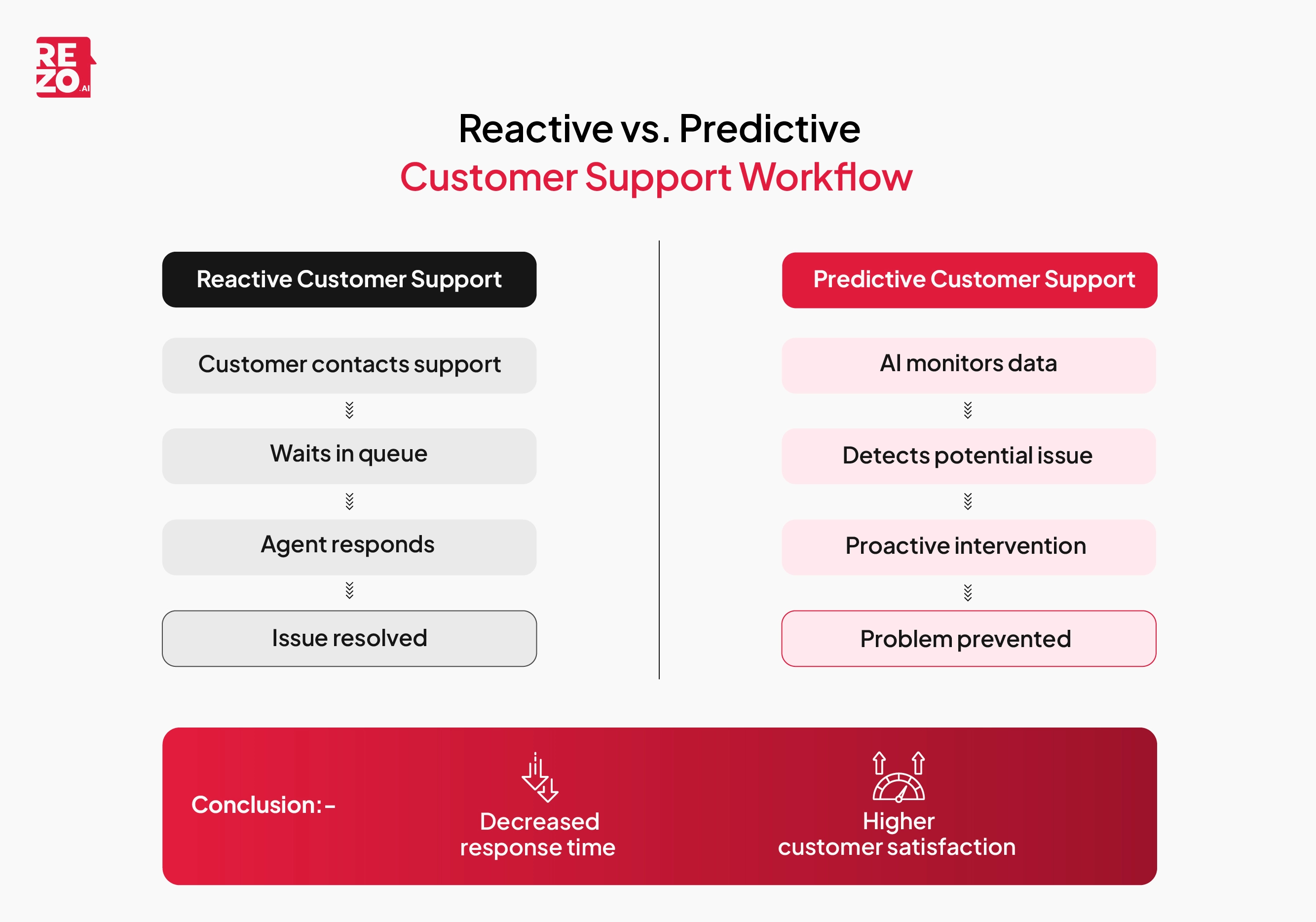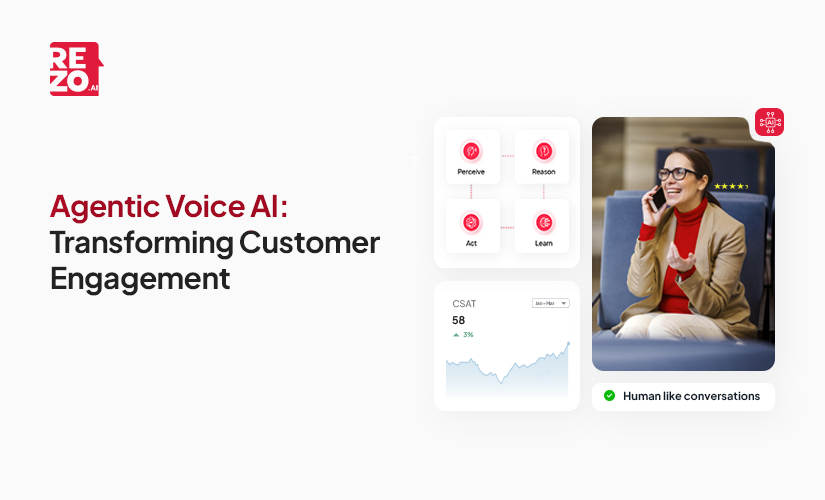
Predictive Customer Support: How Agentic AI Is Revolutionizing CX Automation

Predictive Customer Support: How Agentic AI Is Revolutionizing CX Automation


Imagine this: You're about to check the status of your online order when a notification arrives. It's from the company, letting you know there's a slight delay in shipping, offering you expedited delivery at no charge and a 10% discount on your next purchase. You hadn't even noticed the delay yet, but the issue is already resolved. This isn't science fiction, it's the new reality of predictive customer support powered by agentic AI.
For decades, customer support has operated on a reactive model: customers encounter problems, reach out for help, and wait for solutions. This approach, while functional, is inherently inefficient and often frustrating. Today, a fundamental shift is underway. According to Gartner, by 2029, agentic AI will autonomously resolve 80% of common customer service issues without human intervention, leading to a 30% reduction in operational costs.
The era of predictive, proactive customer support has arrived. In this article, we'll explore how agentic AI is transforming customer support from a reactive cost center into a proactive value driver, the technologies making this possible, how it is driving customer satisfaction levels with tailored solutions and what it means for businesses and customers in real world environment.
The Evolution from Reactive to Predictive Support
The Traditional Reactive Model
The traditional customer support paradigm follows a predictable pattern: a customer encounters a problem, contacts support through phone, email, or chat, and an agent responds to resolve the issue. While this model has served businesses for years, its limitations are increasingly apparent.
This reactive approach is slow, resource-intensive, and delivers a suboptimal customer experience. Support teams spend the majority of their time addressing routine, preventable issues that could have been resolved proactively. Customers wait in queues, repeat information across channels, and often feel frustrated by the time they receive help.
The Predictive Support Paradigm
Predictive customer support flips this model on its head. Instead of waiting for customers to report problems, AI models anticipates customer issues before they occur, predict the customer needs, intervene proactively, and often prevent problems from ever affecting the customer experience.
The workflow looks dramatically different:- AI agents continuously monitors data across systems, identifies patterns indicating potential issues, predicts problems before they manifest, and automatically resolves issues by taking corrective action. The customer often never knows there was a problem because it was resolved before it impacted them.
The benefits are substantial. Research shows that customers who were contacted proactively felt a positive shift in how they viewed the brand thus boosting customer loyalty. This approach improves satisfaction, reduces costs through issue prevention, and enables better resource allocation by addressing problems before they escalate into high-touch support cases.

Need for Predictive Customer Support
Several factors have converged to make predictive customer support not just possible, but essential. The technological foundation now exists:- machine learning models and algorithms can process vast amounts of data in real-time, cloud computing provides the infrastructure to scale these capabilities, and natural language processing enables sophisticated customer interactions.
Customer expectations have also evolved dramatically. In an era when Amazon predicts what you want to buy and Netflix knows what you want to watch, customers expect businesses to anticipate their needs.
Finally, competitive pressure is driving adoption. As early movers demonstrate the value of automated customer service, businesses that stick with reactive-only models risk falling behind. Predictive support is quickly becoming a competitive differentiator and a customer expectation.
Understanding Agentic AI: Beyond Traditional Chatbots
To understand how predictive customer support works, we need to understand what makes agentic AI different from the existing AI chatbots and virtual assistants many businesses already use.
What is Agentic AI?
Agentic AI represents autonomous systems that go beyond scripted responses to independently manage and execute complex processes while also providing personalized services. Unlike traditional artificial intelligence systems that follows predefined rules and offers reactive responses, agentic AI possesses several distinguishing characteristics.
- it operates autonomously with minimal human intervention.
- it exhibits goal-oriented behavior, focusing on achieving specific outcomes rather than simply responding to prompts.
- it has reasoning and planning capabilities, allowing it to analyze situations, determine the best course of action, and adapt its approach based on context.
- it can take action across multiple systems, from CRMs to billing platforms to communication channels without requiring human interaction.
Traditional AI vs. Agentic AI
The differences between traditional AI like generative AI and agentic AI are not merely incremental; they represent a fundamental shift in capabilities.
Traditional AI systems follow predefined rules: "If customer asks about order status, retrieve order information and display it." They provide reactive responses to customer inquiries and typically operate within a single channel. They require extensive human intelligence to handle anything outside their programmed parameters.
Agentic AI, in contrast, makes autonomous decisions based on goals and context. It proactively intervenes before customers even ask for help. It orchestrates workflows across multiple platforms and systems, and it operates independently to achieve defined objectives. As Cisco research indicates, by 2028, 68% of customer service interactions will be handled by agentic AI.
Key Capabilities of Agentic AI Systems That Enable Predictive Support
Several core capabilities enable agentic AI for contact centers to deliver predictive support:
- Natural Language Understanding: The ability to comprehend customer intent, sentiment, and context from conversational language.
- Multi-Step Reasoning: Analysing complex situations, considering multiple factors, and determining optimal courses of action.
- System Integration: Interacting with APIs, databases, and various business systems to gather information and execute actions.
- Workflow Automation: Designing and executing multi-step processes that span different systems and channels.
- Continuous Learning: Refining predictions and improving performance based on outcomes and new data.
According to recent survey by Cisco, 93% of respondents predict that agentic AI will enable more personalized, proactive, and predictive services. A testament to the transformative potential of implementing Agentic AI systems.
How Predictive Customer Support Works?
Understanding the theory is important, but seeing how predictive customer support works in practice brings the concept to life.
Predictive Customer Support in Action
The predictive support process involves five key stages:
- Data Collection: Systems gather comprehensive data including customer behavior patterns, transaction history, interaction logs, product usage metrics, and environmental factors like network performance or logistics data.
- Pattern Recognition: Machine learning algorithms analyze this data to identify signals and trends. For instance, the system might learn that login errors spike after software updates, or that customers who don't complete onboarding within 48 hours have a 60% higher churn rate.
- Predictive Analysis: Based on recognized patterns, the system forecasts potential issues or opportunities. It might predict that a customer's payment will fail, a shipment will be delayed, or a user will struggle with a particular feature.
- Proactive Intervention: The system takes action before problems escalate. This might involve sending a notification, offering a solution, updating an order, or providing resources, all without the customer having to ask.
- Continuous Learning: Every intervention's outcome feeds back into the system, refining future predictions and improving accuracy over time.

Real-World Use Cases
Predictive customer support is already delivering results across industries:
- E-commerce Order Management: When Agentic AI agents detects a shipping delay based on logistics data, it automatically contacts the customer with an update and offers expedited delivery or a discount before the customer even checks their order status. This prevents a potential complaint and often improves customer satisfaction despite the delay driving business success.
- SaaS Product Adoption: AI monitoring product usage detects when a user struggles with a feature:- perhaps they've attempted the same action multiple times without success. The Agentic AI agents proactively offers a tutorial, schedules a demo, or connects them with support. This improves feature adoption, increases customer lifetime and boosts brand loyalty.
- Financial Services Payment Management: Agentic AI systems can predict potential payment failures based on historical patterns, account status, and external factors. It alerts customers with payment alternatives before an account is disrupted, preventing service interruptions and maintaining positive relationships.
- Telecommunications Network Management: Network monitoring data indicates a potential outage affecting specific customers. The system automatically notifies affected customers, provides estimated resolution times, and offers troubleshooting steps if appropriate. This reduces support calls and demonstrates proactive care.
The Business Case: ROI and Impact
For business leaders evaluating AI in customer support, the question isn't just "Can we do this?" but "What's the return on investment?" The data is compelling.
Operational Efficiency Gains
McKinsey research shows that integrating generative AI into customer care functions can drive productivity gains of 30-45%. Support agents utilizing AI tools can handle more customer inquiries per hour, while maintaining or improving quality.
The efficiency gains extend beyond individual agent productivity. Agentic AI provides 24/7 availability without requiring night shifts or weekend staffing. It can handle multiple inquiries simultaneously, something impossible for human agents. And by automating routine inquiries, it allows businesses to scale support without proportional increases in headcount.
Cost Reduction
The financial impact of agentic AI is substantial. Gartner predicts a 30% reduction in operational costs by 2029 for organizations that fully embrace autonomous customer service. Industry-wide, conversational AI is projected to reduce contact center labor costs by $80 billion by 2026.
Early adopters are already seeing results. Among organizations using generative and agentic AI, nearly half expect to cut costs by over 10%. These savings come from multiple sources: reduced need for large support teams, lower training and onboarding costs, reduced operational cost, decreased escalation rates, and prevention of issues that would otherwise require intensive support interventions.
Customer Satisfaction Improvements
Cost reduction matters, but not at the expense of customer experience. Fortunately, predictive customer support improves both. Maruti Suzuki, for example were able to get 75% of an agents work automated with AI agents.
The customer preference for proactive support is clear. Industry report states 87% of customers want companies to contact them proactively, and 73% feel more positive about brands that do so. Predictive customer support delivers faster resolutions, reduces customer effort, improves customer engagement and demonstrates that businesses value their customers' time.
Competitive Advantages
Beyond immediate ROI, predictive customer support creates lasting competitive advantages and fuels business growth. It differentiates businesses in crowded markets where products and pricing may be similar with their superior customer service experience. It enables scaling without proportional cost increases, making rapid growth more sustainable. It frees human agents to focus on complex, high-value interactions that build relationships and solve unique problems. And it generates valuable data insights that inform product development, marketing, and strategic planning.
The adoption rates tell the story:- As per a Capgemini Report 86% of companies have already either implemented generative AI in their customer service processes or are exploring its potential. Of these organizations, 33% have seen a boost in their FCR compared to past customer interactions, while 52% expect to see similar benefits from AI-led customer support.

Balancing Automation with Human Touch
Despite the impressive capabilities of agentic AI, the most successful implementations don't eliminate human agents, they empower them.
The Continued Importance of Human Agents
The data is clear: 89% of customers emphasize the need to combine human connection with AI efficiency. While customer service Agentic AI systems are handling routine tasks, predictive interventions, personalized interactions, strategic initiatives and data analysis, humans oversight remain essential for performing tasks requiring nuanced judgment, situations demanding empathy and emotional intelligence, ethical implications, sensitive issues, relationship building with high-value customers, and edge cases that fall outside normal patterns.
The Optimal Human-AI Collaboration Model
The most effective approach treats AI agents and humans as complementary rather than competitive. How agentic AI makes scalability effortless for CX teams is by handling the high-volume, routine workload, freeing human employees for higher-value activities.
In this proactive approach model, AI agents handles routine and complex queries, real time data processing, predictive interventions, initial triage and information gathering, and complex workflow automation across systems. Human agents focus on complex tasks requiring creative solutions, escalations and sensitive situations, strategic relationship management, and decisions requiring empathy and contextual judgment.
Augmentation, Not Replacement
The goal is augmentation, not replacement. AI agents removes repetitive tasks from agents' workloads, allowing them to focus on engaging, meaningful interactions. It provides agents with insights, recommendations, and context that make them more effective. It handles the volume spikes across multiple channels that would otherwise overwhelm teams. And importantly, it often improves job satisfaction by eliminating the most tedious aspects of support work while not compromising on customer service experience.
Thus you can say, Agentic AI doesn't replace the human element, rather elevates it, handling routine tasks and providing consistent support so humans can focus on building relationships and solving complex problems with empathy and creativity.
Implementing Predictive Support with Agentic AI
For Enterprises and Call Centers ready to embrace predictive customer support, success requires thoughtful planning and execution.
Key Implementation Considerations
- Data Infrastructure: Predictive customer support requires robust data collection, storage, and processing capabilities. Organizations need systems that can capture relevant data across touchpoints and make it accessible for analysis.
- System Integration: Agentic AI must connect with CRMs, billing platforms, inventory systems, communication channels, and other business processes. The more integrated your systems, the more effective predictive support becomes.
- Training and Change Management: Implementing contact center automation requires preparing teams for new workflows, roles, and responsibilities. Agents need training on how to work alongside AI, and managers need new metrics and management approaches.
- Privacy and Security: Predictive support relies on customer data, making data privacy and security paramount. Ensure robust security measures and compliance with regulations like GDPR and CCPA, implement strong data protection measures, and maintain transparency about how customer data is used.
- Continuous Monitoring: Implementing AI isn't a one-time project. Organizations need ongoing monitoring of performance metrics, refinement of algorithms based on results, and adjustment of interventions as patterns change.
Best Practices for Implementing Predictive Customer Support
- Start with high-volume, low-complexity use cases where the ROI is clearest and the risk is lowest. Define clear metrics for success not just efficiency metrics like cost per contact, but also customer satisfaction, resolution rates, and business outcomes.
- Maintain transparency with customers about the digital transformation and use of AI. Most customers are comfortable with AI interactions when they understand what's happening and can reach a human if needed. Create clear escalation paths for situations that require human intervention.
- Finally, iterate based on data. Use the insights generated by your predictive support system to continuously improve. What patterns are emerging? Which interventions work best? Where do customers still need human support? Let the data guide your evolution.
The Future of Predictive Customer Support
The capabilities available today are impressive, but they're just the beginning. Over the coming years, we can expect predictive customer support to become more prevalent.
Near-term Evolution (2025-2026)
Over the next year or two, expect widespread adoption of predictive analytics in customer support, enhanced natural language capabilities that make AI interactions more natural and effective, and improved cross-channel communication that maintains context as customers move between touchpoints ensuring an omnichannel experience.
Mid-term Transformation (2027-2028)
By 2028, Cisco predicts 68% of customer service interactions will be handled by agentic AI. This period will see advanced autonomous decision-making capabilities, where AI makes increasingly complex decisions without human approval, and sophisticated predictive modeling that anticipates customer needs with remarkable accuracy.
Long-term Vision (2029+)
Looking toward 2029 and beyond, Gartner's prediction of 80% autonomous resolution of common issues will likely be realized. We'll see seamless human-AI collaboration where handoffs are smooth and context is never lost, AI agents capable of handling complex negotiations like contract renewals or service modifications, and hyper-personalized predictive experiences where every customer receives individualized, proactive support tailored to their unique needs and preferences.
Emerging Trends
Several emerging trends are worth watching: voice-based agentic AI that provides conversational support via phone or voice assistants, emotion detection capabilities that allow AI to recognize frustration or satisfaction and adjust accordingly, industry-specific specialized agents trained on domain expertise and market trends for healthcare, financial institutions, or other verticals, and predictive experience orchestration that extends beyond support to create proactive experiences across the entire customer journey.

Conclusion
The transformation from reactive to predictive customer support represents more than a technological upgrade, it's a fundamental reimagining of how businesses serve customers. By implementing agentic AI, organizations can identify customer behaviors, anticipate needs, allocate resources, prevent problems, and deliver the proactive, personalized experiences today's customers expect.
Thus, Agentic AI in proactive customer support is compelling and its adoption is accelerating rapidly.
The question isn't whether predictive customer support will become standard, it's whether your organization will be a leader or a follower in this transformation. The future of customer support is predictive, proactive, and powered by agentic AI. The time to start your journey is now.
Frequently Asked Questions
What is Proactive Customer Support?
Proactive customer support can predict and resolve issues before customers can even anticipate them. This vastly improves customer experience and increases brand loyalty.
How AI is used in Predictive customer support?
Artificial intelligence systems can be used to gain insights into customer's behaviour, understand their needs, identify patterns and take optimized decisions based on that.
How is artificial intelligence used in predicting customer behaviors?
AI systems can readily forecast customer requirements by analyzing past interactions, purchase trends, browsing history, and current market trends. With these insights, they can then launch personalized marketing campaigns and solutions to customers.
Frequently Asked Questions (FAQs)

Take the leap towards innovation with Rezo.ai
Get started now














